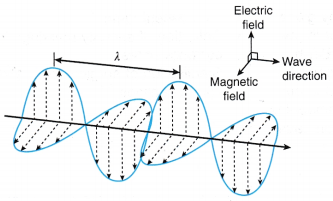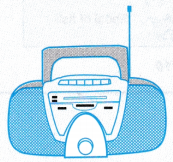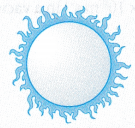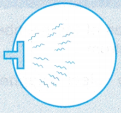Classification Of Wave Motion
On the Bases of Necessity of Medium Required
MECHANICAL WAVES
The wave which propagates only in a material medium are called elastic or mechanical waves.
Example: Sound waves, Water waves (ripples), Waves on stretched strings, Earthquake waves and the Shock waves produced by a supersonic aircraft are mechanical (or elastic) waves.
ELECTROMAGNETIC WAVES
Wave which do not require any material medium for their propagation are called electromagnetic waves.
Example: Light waves, Radio waves, Television waves, and X-rays are electromagnetic waves. Thus, Light waves, Radio and Television waves, and X-rays can also travel through vaccum.
Difference between mechanical waves & electromagnetic waves
| Mechanical waves | Electromagnetic waves | |
| 1. | Mechanical waves need a material medium for their propagation. These waves cannot travel through vacuum. | Electromagnetic waves do not need any material medium for their propagation. These waves can travel through vacuum. |
| 2. | Speed of mechanical waves are low and depends upon the source and the medium through which they travel. | (EMW) a electromagnetic waves travel with the speed of light (3 × 108 m/s) in vaccum. The speed of an electromagnetic wave in any material medium is less than that in vaccum. |
| 3. | Mechanical waves are due to the vibrations of the particles of the medium. | (EMW) a electromagnetic waves are not due to vibration of medium particles |
| 4. | Mechanical waves may be longitudinal or transverse waves. | Electromagnetic are transverse waves. |
| 5. | Example: Sound waves, water waves, string waves are mechanical waves. | Examples: Light waves, radio and TV waves, and X-rays are electromagneti |
TRANSVERSE WAVES On the Basis of mode of Vibration of the Particle
A wave in which the particles of the medium oscillate about their mean position in a direction perpendicular to the direction of propagation of the wave is called a transverse wave.
Transverse waves can travel through solids and over the surface of liquids, but not through gases.
Examples: Following are the examples of transverse waves
- The water waves (ripples) produced on the surface of water is transverse waves. In water waves, the molecules of water move up and down from their mean positions.
- A pulse on a slinky when it is given a jerk is a transverse wave.
- All electromagnetic waves, e.g., light waves, radio waves etc., are transverse waves.
- The waves produced in a stretched string when plucked are transverse waves. When a string of sitar (a musical instrument) or guitar is plucked, transverse waves are produced in the string.
Graphical Representation:

(a) Crest: The highest point on the hump in a transverse wave is called a crest. Thus, the point of maximum positive displacement on a transverse wave is called a crest.
(b) Trough: The lowest point on the depression in a transverse wave is called a trough. Thus, the point of maximum negative displacement on a transverse wave is called a trough.
LONGITUDINAL WAVES
A wave in which the particle of the medium oscillate (vibrate) to and fro about their mean position in the direction of propagation of the wave is called a longitudinal wave.
Longitudinal waves can be produced in any medium, viz., in solids, liquids and in gases.
Example:
(i) Sound waves are longitudinal waves.
(ii) The waves produced in a spring (slinky) by compressing a small portion of it and releasing are longitudinal waves.
Graphical Representation:

(a) Compression: The part of a longitudinal wave in which the density of the particles of the medium is higher than the normal density is called a compression.
(b) Rarefaction: The part of a longitudinal wave in which the density of the particles of the medium is lesser than the normal density is called a rarefaction.
What is the difference between longitudinal and transverse waves?
| Longitudinal | Transverse waves | |
| 1 | In a longitudinal wave the particles of the medium oscillate along the direction of propagation of the wave. | In a transverse wave, the particles of the medium oscillate in a direction perpendicular to the direction of propagation of the wave |
| 2 | Longitudinal waves can propagate through solids, liquids, as well as gases. | Transverse waves can propagate through solids, and over the surface of liquids, but not through gases. |
| 3 | Longitudinal waves consist of compression and rarefactions. | Transverse waves consist of crests and troughs. |
Transverse Waves and Longitudinal Waves Experiment
Aim: To study transverse waves and longitudinal waves using a slinky spring.
Material: Ribbon
Apparatus: Slinky spring
Method:

- A slinky spring is placed on the floor. One end of it is tied to the leg of a table.
- A short length of ribbon is tied to any part of the spring between the two ends.
- A set of transverse waves is produced by vibrating the spring at right angles with it as shown in Figure The movement of the ribbon is observed.

- A set of longitudinal waves is produced by vibrating the spring in a to-and-fro direction as shown in Figure The movement of the ribbon is observed.

Observations:
- In step 3, the ribbon is displaced in an up-and-down motion which is perpendicular with the direction of the propagation of the waves.
- In step 4, the ribbon is displaced in a to-and-fro motion which is parallel with the direction of the propagation of the waves.
Discussion:
- The ribbon tied to the slinky spring represents the particles of the medium of the waves.
- Step 3 shows that any point on the spring is displaced in an up-and-down motion which is perpendicular with the direction of the propagation of the waves.
- Step 4 shows that any point on the spring is displaced in a to-and-fro motion which is parallel with the direction of the propagation of the waves.
Conclusions:
- For transverse waves, the particles of the medium move in a direction perpendicular to the direction of the propagation of the waves.
- For longitudinal waves, the particles of the medium move in a direction parallel to the direction of the propagation of the waves.








